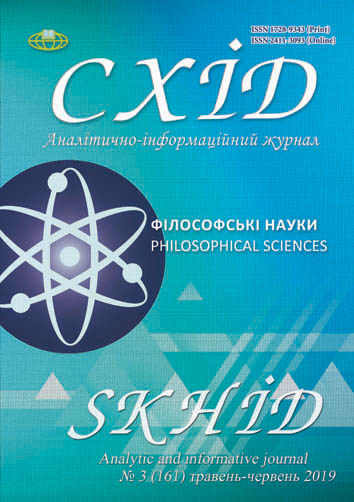Constitution of social reality: from “lebenswelt” of Husserl to Garfinkel’s “practical thinking”
DOI:
https://doi.org/10.21847/1728-9343.2019.3(161).171718Keywords:
society, phenomenology, social order, constitution, lifeworld, ethnomethodology, pre scientific knowledgeAbstract
The issue is devoted to the possibilities of social reality’s interpretations. Edmund Husserl’s and Alfred Schutz’s conceptions of “lifeworld” are analyzed as well as a place of common life in Harold Garfinkel’s ethnomethodology. The author highlights the exceptional role of social order constitution in social phenomenology. Social reality, its definitions and characteristics play a crucial role in development of humanitarian science. Understanding of social reality is fundamental for social and phenomenological directions of modern philosophy; nevertheless the issue has not had sufficient theoretical considerations in Ukraine. The aim of the issue was to determine the ways of social reality’s constitution within the works of Husserl, Schutz and Garfinkel. The constitutional ways of social reality were systematically analyzed for the first time at the work form Husserl’s conception through Schutz’s philosophy to Garfinkel’s ethnomethodology. As a result the characteristics of social reality were determined in phenomenological and ethnomethodological studies. Moreover, it was pioneering to demonstrate history and transformational changes in social reality understanding from “lifeworld” in phenomenology to “practical thinking” in ethnomethodology. The presented work, based on Ukrainian and Western scientific studies and original sources, offers the main conclusions about characteristics of social reality in the abovementioned works. Theoretical value of a study refers to the further scientific thought development about phenomenology, ethnomethodology as well as to the fundamental meaning of social reality for these spheres. Practical value of a study affects the opportunities to apply the defined features of social reality and its constitution to practical activity.Downloads
References
American sociological thought: Texts. (1994). Moscow: Moscow State University. (In Russian)
Berger, Peter L. and Luckmann, Thomas (1995). The Social Construction of Reality (transl.) Moscow: Medium, 323 p. (In Russian)
Bystrytsky, Ye. (2012). Transtsendentalna fenomenolohiya i ponyattya dosvidu. Filosofska dumka, №5. Pp. 113-132. (In Ukrainian)
Cooley, Charles Horton (1902). Human nature and the social order. New York: C. Scribner's sons. Retrieved from https://archive.org/details/humannaturesocia00cooluoft/page/x
Garfinkel, H. (2002). What is Ethnomethodology? In: Garfinkel, H., Rawls, A. W. (ed.). Ethnomethodology’s program: working out Durkheim’s aphorism. Lanham: Rowman & Littlefield. Рp. 91-99. (In English)
Garfinkel, Harold (2005). Ethnomethodological Studies of Work. London: Routledge. DOI: https://doi.org/10.4324/9780203996867.
Husserl, Edmund (1970). The Crisis of European Sciences and Transcendental Philosophy, Northwestern University Press. (In English)
Kebuladze, V. I. (1998). Intersubyektyvne vchennya E. Husserlya yak transtsendentalnyy fon fenomenolohichnoyi kontseptsiyi dosvidu A. Shyutsa: Avtoref. dys… k.filos.n.: 09.00.05. Kyyiv: KNU, 1998. Retrieved from http://cheloveknauka.com/intersubektivnoe-uchenie-e-gusserlya-kak-tarnstsendentalnyy-fon-fenomenologicheskoy-kontseptsii-opyta-a-shyutsa#ixzz5rNdUBQw3
Kenneth, Allan (2005). Explorations in classical sociological theory: seeing the social world. Thousand Oaks: Pine Forge Press. p. 314 (In English)
Kosharnyy, S. O. (2005). Fenomenolohichna kontseptsiya filosofiyi E. Huserlya: krytychnyy analiz. Kyiv: Ukrayinskyy tsentr dukhovnoyi kultury (In Ukrainian).
Kotsyuba, Maksym (2017). Fenomenolohichna filosofiya: vid «dosvidu Inshoho» do «dosvidu etychnoho». Filosofska dumka, №5. pp. 90-98. (In Ukrainian)
Parsons, Talcott (2002). The Structure of Social Action (translat. from English). Moscow: Akademicheskii proekt (In Russian)
Proleev, S. (2009). Profetyzm modernoyi nimetskoyi filosofiyi: K. Marks i E. Husserl. Filosofska dumka, №1. Pp. 125-133. (In Ukrainian)
Prychepiy, Ye. M. (1971). Fenomenolohichna teoriya svidomosti E. Husserlya. Krytychnyy narys. Kyiv: Naukova dumka, 1971 (In Ukrainian)
Ricoeur, Paul (1967). Husserl. An Analysis of His Phenomenology. Northwestern University Press. (In English)
Schutz, Alfred, and Luckmann, Thomas (1974). The Structures of the Life-World. (Strukturen der Lebenswelt.) Translated by Richard M. Zaner and H. Tristram Engelhardt, Jr. Evanston, IL: Northwestern University Press. (In English)
Shyuts, A. (2003). Smyslovaya struktura povsednevnogo mira: ocherki po fenomenologicheskoy sotsiologii. Moscow: Institute of the Fund "Public opinion" (In Russian)
Simmel, Georg. (1996). Izbrannoye: Tom 2. Sozertsaniye zhizni. Moscow: Yurist, 608 p. (In Russian)
Vom Lehn, D. (2014). Harold Garfinkel. New York: Routledge, DOI: https://doi.org/10.4324/9781315427652
Downloads
Published
How to Cite
Issue
Section
License
Copyright (c) 2019 Anastasia Kosinska

This work is licensed under a Creative Commons Attribution-NonCommercial-NoDerivatives 4.0 International License.
1. Authors bear responsibility for the accuracy of facts, quotations, numbers and names used.
2. Manuscripts are not sent back.
3. The publisher does not always agree with the authors' opinion.
4. The authors reserve the right to authorship of the work and pass the first publication right of this work to the journal under the terms of a Creative Commons Attribution-NonCommercial-NoDerivatives 4.0 International License. This license allows others to distribute (copy) the published work for non-commercial purposes, provided there is mandatory attribution to its authors and a link to the first publication in our journal.
5. The authors have the right to conclude separate supplement agreements that relate to non-exclusive work distribution in the form in which it has been published by the journal (for example, to upload the work to the online storage of the journal or publish it as part of a monograph), provided that the reference to the first publication of the work in this journal is included.

